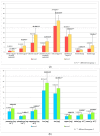Plasma and Salivary Non-Urate Total Antioxidant Capacity Does Not Depend on Dietary Vitamin C, E, or β-Carotene Intake in Older Subjects
- PMID: 29690623
- PMCID: PMC6017164
- DOI: 10.3390/molecules23040983
Plasma and Salivary Non-Urate Total Antioxidant Capacity Does Not Depend on Dietary Vitamin C, E, or β-Carotene Intake in Older Subjects
Abstract
The native Total Antioxidant Capacity (TAC) of plasma and saliva is generally determined by uric acid (UA). Several studies have assessed the impact of habitual dietary antioxidative vitamin intake on TAC, but it remains unknown whether it influences Non-Urate Total Antioxidant Capacity (Nu-TAC), i.e., TAC after enzymatic UA elimination. The purpose of this study was to assess whether the intake of antioxidative vitamins C, E, and β-carotene, provided with usual daily food rations, affects plasma and salivary Nu-TAC. The study involved 56 older subjects (aged 66.9 ± 4.3 years), divided into two age- and sex-matched groups: group 1 (n = 28), with lower combined vitamin C, E, and β-carotene intake, and group 2 (n = 28), with higher intake. A 24 h dietary recall was obtained from each individual. Nu-TAC was assessed simultaneously with two methods in plasma (Ferric Reducing Ability of Plasma—Nu-FRAP, 2.2-diphenyl-1-picryl-hydrazyl—Nu-DPPH) and in saliva (Nu-FRAS and Nu-DPPHS test). No differences were found in the Nu-TAC parameters between the groups, either in plasma (Nu-FRAP, Nu-DPPH) or in saliva (Nu-FRAS, Nu-DPPHS) (p > 0.05). No plasma or salivary Nu-TAC indices correlated with dietary vitamin C, E, or β-carotene intake or with other nutrients. Habitual, not extra-supplemented dietary intake does not significantly affect plasma or salivary Nu-TAC.
Keywords: DPPH; FRAP; habitual diet; non-urate total antioxidant capacity; nutrition; plasma; saliva; vitamin C intake; vitamin E intake; β-carotene.
Conflict of interest statement
The authors declare no conflict of interest. The founding sponsors had no role in the design of the study; in the collection, analyses, or interpretation of data; in the writing of the manuscript, and in the decision to publish the results.
Figures


Similar articles
-
Dietary Vitamin C, E and β-Carotene Intake Does Not Significantly Affect Plasma or Salivary Antioxidant Indices and Salivary C-Reactive Protein in Older Subjects.Nutrients. 2017 Jul 9;9(7):729. doi: 10.3390/nu9070729. Nutrients. 2017. PMID: 28698489 Free PMC article.
-
A comparison of native and non-urate Total Antioxidant Capacity of fasting plasma and saliva among middle-aged and older subjects.Redox Rep. 2018 Dec;23(1):57-62. doi: 10.1080/13510002.2017.1392714. Epub 2017 Oct 31. Redox Rep. 2018. PMID: 29088986 Free PMC article.
-
Salivary and plasma native and non-urate total antioxidant capacity versus oral health status in older non-smoking adults.Arch Oral Biol. 2019 Nov;107:104515. doi: 10.1016/j.archoralbio.2019.104515. Epub 2019 Aug 5. Arch Oral Biol. 2019. PMID: 31442934
-
Diet and obstructive lung diseases.Epidemiol Rev. 2001;23(2):268-87. doi: 10.1093/oxfordjournals.epirev.a000806. Epidemiol Rev. 2001. PMID: 12192737 Review.
-
Antioxidant functions of vitamins. Vitamins E and C, beta-carotene, and other carotenoids.Ann N Y Acad Sci. 1992 Sep 30;669:7-20. doi: 10.1111/j.1749-6632.1992.tb17085.x. Ann N Y Acad Sci. 1992. PMID: 1444060 Review.
Cited by
-
Androgen Deprivation Therapy in Patients With Prostate Cancer Increases Serum Levels of Thromboxane A2: Cardiovascular Implications.Front Cardiovasc Med. 2021 Apr 13;8:653126. doi: 10.3389/fcvm.2021.653126. eCollection 2021. Front Cardiovasc Med. 2021. PMID: 33928136 Free PMC article.
-
Plasma Non-Enzymatic Antioxidant Capacity (NEAC) in Relation to Dietary NEAC, Nutrient Antioxidants and Inflammation-Related Biomarkers.Antioxidants (Basel). 2020 Apr 5;9(4):301. doi: 10.3390/antiox9040301. Antioxidants (Basel). 2020. PMID: 32260517 Free PMC article.
-
The Relationship Between Salivary Redox, Diet, and Food Flavor Perception.Front Nutr. 2021 Jan 28;7:612735. doi: 10.3389/fnut.2020.612735. eCollection 2020. Front Nutr. 2021. PMID: 33585536 Free PMC article. Review.
-
Oxidative Stress in Association with Metabolic Health and Obesity in Young Adults.Oxid Med Cell Longev. 2021 Jun 26;2021:9987352. doi: 10.1155/2021/9987352. eCollection 2021. Oxid Med Cell Longev. 2021. PMID: 34257828 Free PMC article.
References
-
- Miller C.S., Foley J.D., Floriano P.N., Christodoulides N., Ebersole J.L., Campbell C.L., Bailey A.L., Rose B.G., Kinane D.F., Novak M.J., et al. Utility of salivary biomarkers for demonstrating acute myocardial infarction. J. Dent. Res. 2014;93:72S–79S. doi: 10.1177/0022034514537522. - DOI - PMC - PubMed
MeSH terms
Substances
LinkOut - more resources
Full Text Sources
Other Literature Sources
Medical
Research Materials
Miscellaneous

